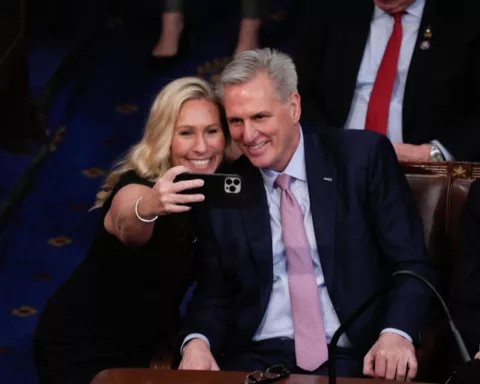U.S. President Joe Biden did the opposite on Thursday — holding photo opportunities with a poorly maintained bridge as the backdrop and then touring a decrepit water treatment plant, with cameras in tow.
“We’re standing here in the shadow of the I-10 bridge, which I’ve gone over several times myself in the past. And it’s a perfect example how we’ve neglected as a nation to invest in the future of our economy and the future of our people,” said Biden in Lake Charles, Louisiana, after he was introduced by the city’s Republican mayor.
“Mr. President, any members of Congress out there who might be listening — Lake Charles needs help right now, and we’re asking for it,” Mayor Nic Hunter said.
Biden proposes spending $2.3 trillion on infrastructure and jobs across the country. His visit, in part, was a challenge to Louisiana’s congressional delegation, which at the moment is exclusively Republican — until Representative-elect Troy Carter takes his House seat May 11 to represent the majority Black 2nd District.
Narrower approach
Republicans insist on a narrower approach to infrastructure — repairing roads and bridges, modernizing transit and expanding broadband internet access, rather than spending money on renewable energy and care for the elderly.
Biden’s American Jobs Plan is a “budget-busting tax hike spending boondoggle masquerading as an infrastructure bill,” said Republican Steve Scalise, who represents portions of Louisiana in the House. “Raising taxes that will force middle-class jobs overseas is not infrastructure.”
Former President Donald Trump beat Biden in the state by nearly 20% in the 2020 presidential election.
Despite the loss in Louisiana, Biden “is the president for everyone,” Karine Jean-Pierre, White House deputy press secretary, told reporters on Air Force One during Thursday’s flight to the state.
Republican lawmakers oppose Biden’s plan to fund projects with higher corporate taxes. The president contends such a tax hike would fund $115 billion for roads and bridges, and hundreds of billions of dollars more to modernize the electrical grid, provide better-quality drinking water, rebuild homes and accelerate the manufacturing of electric vehicles.
The attempt to sell his package beyond his Democratic base is why Biden was pictured on Thursday at the Calcasieu River Bridge on Interstate 10 in Lake Charles. The bridge opened to vehicular traffic in 1952 and currently carries 80,000 cars and trucks daily. It is considered by structural engineers to be one of the most dangerous bridges in the United States.
Operating the bridge beyond its anticipated 50-year life span is “a recipe for disaster,” Biden said.
Later in the afternoon, the president visited the Carrollton Water Plant in New Orleans, which provides drinking water to the country’s 50th-largest city.
New Orleans is a major port city on the Mississippi River and the Gulf Coast, sitting in bowl-shaped terrain that frequently floods.
About half of the century-old plant’s turbines have failed in the past year. One of them exploded in 2019. Many of its pipes for water purification are crumbling.
“The whole system could fail,” Ghassan Korban, executive director of the sewerage and water board of New Orleans, warned the president.
Biden commented that water infrastructure, frequently overlooked, is a key element for “making life livable for ordinary people.”
‘Blue-collar blueprint’
Biden said his “blue-collar blueprint” would help fix the bridge, the water facility and thousands more like them across the United States.
On top of their long-existing infrastructure woes, the areas Biden toured, with quickly vanishing coastlines and wetlands, are fighting a losing battle — one that scientists say is exacerbated by a changing climate.
Two devastating hurricanes ripped through southwestern Louisiana last year, and the region is bracing for the start of this year’s hurricane season, which officially begins in less than a month.
“I know times have been tough here, and the damage from the hurricanes has been devastating,” Biden said during his remarks in Lake Charles, calling for hardened standards for new infrastructure projects as they “have to be built to withstand heavy winds and hurricanes.”






